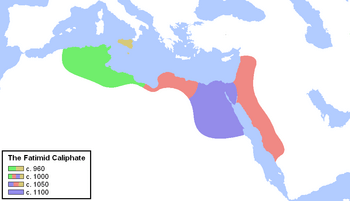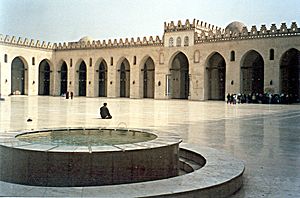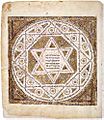Fatimid Caliphate facts for kids
Quick facts for kids
Fatimid Islamic Caliphate
الدولة الفاطمية
|
|||||||||||
|---|---|---|---|---|---|---|---|---|---|---|---|
| 909–1171 | |||||||||||
|
Flag
|
|||||||||||

Chronological map of the Fatimid Caliphate
|
|||||||||||
| Capital | Mahdia (909-969) Cairo (969-1171) |
||||||||||
| Religion | Ismaili Shi'a Islam | ||||||||||
| Government | Monarchy | ||||||||||
| Caliph | |||||||||||
|
• 909-934 (first)
|
Ubayd Allah al-Mahdi Billah | ||||||||||
|
• 1160-1171 (last)
|
Al-'Āḍid | ||||||||||
| History | |||||||||||
|
• Established
|
5 January 909 | ||||||||||
|
• Foundation of Cairo
|
August 8, 969 | ||||||||||
|
• Disestablished
|
1171 | ||||||||||
| Area | |||||||||||
| 5,100,000 km2 (2,000,000 sq mi) | |||||||||||
| Population | |||||||||||
|
•
|
62000000 | ||||||||||
| Currency | Dinar | ||||||||||
|
|||||||||||
The Fatimid Caliphate was a powerful empire ruled by the al-Fātimiyyūn family. They were an Arab Shi'a dynasty. This empire lasted from 909 to 1171.
At different times, the Fatimids controlled large parts of North Africa, Egypt, and the Levant (which is the eastern Mediterranean region). The famous Egyptian city of Cairo became their capital.
The Fatimid leaders were also important religious figures. They were seen as Shia Ismaili Imams. This meant they had special religious meaning for Ismaili Muslims. For a time, the religious leadership (Imamate) and the political leadership (Caliphate) were united under the Fatimids. This was very rare in Islamic history.
The Fatimids were known for being quite tolerant of different religions. They allowed various groups, including other types of Muslims, Jews, and Coptic Christians, to practice their faiths freely. However, there were a few times when this tolerance was not shown.
Contents
How the Fatimids Rose to Power

The Fatimid dynasty started in Ifriqiya. This area is now modern-day Tunisia and eastern Algeria.
The empire was founded in 909 by ˤAbdullāh al-Mahdī Billah. He claimed to be a descendant of the Islamic prophet Muhammad. His family line came through Muhammad's daughter, Fātima as-Zahra, and her husband, ˤAlī ibn-Abī-Tālib. This is why the dynasty was called al-Fātimiyyūn, meaning "Fatimid."
Abdullāh al-Mahdi quickly gained control over a large part of central Maghreb. This region includes modern Morocco, Algeria, Tunisia, and Libya. He ruled from Mahdia, a new capital city he built in Tunisia.
The Decline and End of the Fatimids
In the 1040s, the Zirids were governors in North Africa for the Fatimids. They decided to become independent and changed their religion to Sunni Islam. This led to damaging invasions by the Banu Hilal tribe.
After about 1070, the Fatimids started losing control of the Levant and parts of Syria. First, Turkic groups like the Seljuks attacked. Then, the Crusaders arrived. Because of these challenges, the Fatimid empire became much smaller. It eventually only included Egypt.
By the 1160s, the Fatimid government was very weak. A ruler named Nur ad-Din sent his general, Shirkuh, to take over Egypt. Shirkuh captured Egypt from the vizier (a high official) Shawar in 1169.
Shirkuh died just two months after taking power. His nephew, Saladin, then took control. This marked the beginning of the Kurdish Ayyubid Dynasty in Egypt. The Fatimid Caliphate officially ended in 1171.
Fatimid Caliphs
The Fatimid Caliphs were the rulers and religious leaders of the Fatimid Caliphate. Here is a list of the main caliphs:
- Abū Muḥammad ˤAbdu l-Lāh (ˤUbaydu l-Lāh) al-Mahdī bi'llāh (909-934) - He founded the Fatimid dynasty.
- Abū l-Qāsim Muḥammad al-Qā'im bi-Amr Allāh (934-946)
- Abū Ṭāhir Ismā'il al-Manṣūr bi-llāh (946-953)
- Abū Tamīm Ma'add al-Mu'izz li-Dīn Allāh (953-975) - Egypt was conquered during his rule.
- Abū Manṣūr Nizār al-'Azīz bi-llāh (975-996)
- Abū 'Alī al-Manṣūr al-Ḥākim bi-Amr Allāh (996-1021)
- Abū'l-Ḥasan 'Alī al-Ẓāhir li-I'zāz Dīn Allāh (1021-1036)
- Abū Tamīm Ma'add al-Mustanṣir bi-llāh (1036-1094)
- al-Musta'lī bi-llāh (1094-1101) - Disagreements over who should rule after him led to a split among Ismaili Muslims.
- al-Āmir bi-Aḥkām Allāh (1101-1130) - After him, some Ismaili groups did not recognize the Fatimid rulers of Egypt as Imams.
- 'Abd al-Majīd al-Ḥāfiẓ (1130-1149)
- al-Ẓāfir (1149-1154)
- al-Fā'iz (1154-1160)
- al-'Āḍid (1160-1171) - The last Fatimid Caliph.
Images for kids
-
Al-Azhar Mosque in Cairo, built by the Fatimids between 970 and 972
-
Al-Salih Tala'i Mosque in Cairo, built by Tala'i ibn Ruzzik in 1160 and originally intended to house the head of Husayn (the head ended up being interred instead at the present-day al-Hussein Mosque)
-
The original Fatimid-period mihrab inside the al-Azhar Mosque
-
Side chapel in the Hanging Church in Old Cairo, including frescoes (partly visible behind the screen here) dating from the late 12th or 13th century, before the church's later renovation
-
Cover page of the Leningrad Codex, a manuscript of the Hebrew Bible copied in Cairo/Fustat in the early 11th century
-
Fragment of a bowl depicting a mounted warrior, 11th century. Fatimid dynasty, found in Fustat, Egypt. Brooklyn Museum
See also
 In Spanish: Califato fatimí para niños
In Spanish: Califato fatimí para niños










